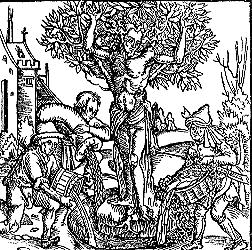![]()
![]()
![]()
![]()
![]()

A human Tree of Life
The identification of this tree varied among cultures and time periods.
To the Druids, the tree of life was the Oak, due to its age and the fact
that it was the host for mistletoe, their most sacred plant. To the ancient
Hebrews, it  was
the Cedar, which provided wood and a delicate, precious oil. The Assyrians
depicted the tree of life as a Date tree, and since they artificially pollinated
their date trees to produce a greater amount of fruit, to them it was not
only a source of food but a symbol of conception. Also, the fruit provided
a date wine which was used as a libation to the gods. was
the Cedar, which provided wood and a delicate, precious oil. The Assyrians
depicted the tree of life as a Date tree, and since they artificially pollinated
their date trees to produce a greater amount of fruit, to them it was not
only a source of food but a symbol of conception. Also, the fruit provided
a date wine which was used as a libation to the gods.
Biblically, the tree of life is the Sycamore, which appears often in the Scriptures. To most, this suggests the western Sycamore, the Plant tree (Platanus). However, the ancient Egyptians also regarded the Sycamore as their sacred "tree of life," and so the idea that this is the Platanus Sycamore must be questioned, as that species is not indigenous to the Nile Valley. In reality, the Sycamore of the Bible was the wild Fig tree, dedicated to fertility, joy, and the afterlife. The fig tree has a leaf very similar to that of a mulberry tree, and over the years the two Greek words for fig and mulberry (sycos and moros) united to form the name Sycamore. No "real" Sycamore was ever a tree of life. Ficus sycamorus, the Sycamore of the Bible, which is in reality a fig tree. |
![]()
![]()
BACK to The Tree of Knowledge | RETURN to Mythical Plants of the Middle Ages
This page © 2000 James L. Matterer
Please visit The Gode Cookery Bookshop | This site hosted by Visual Presence